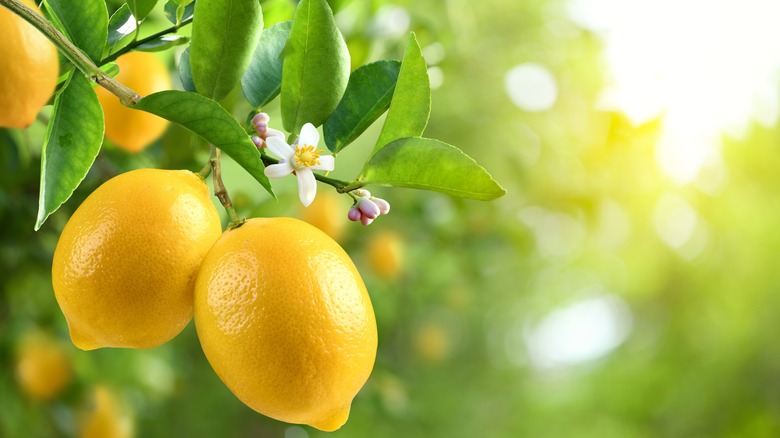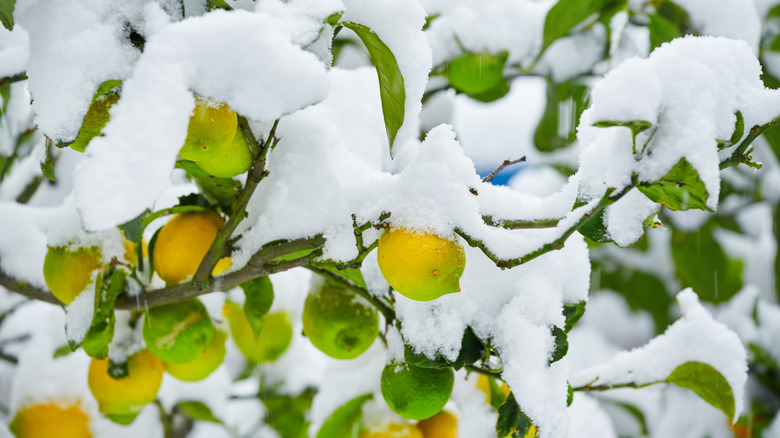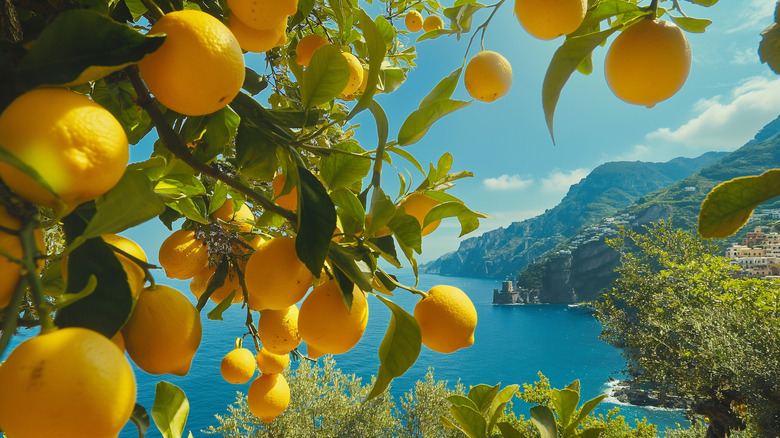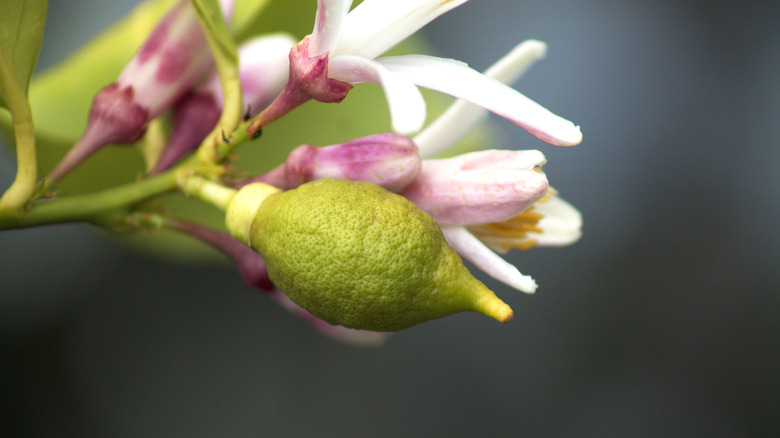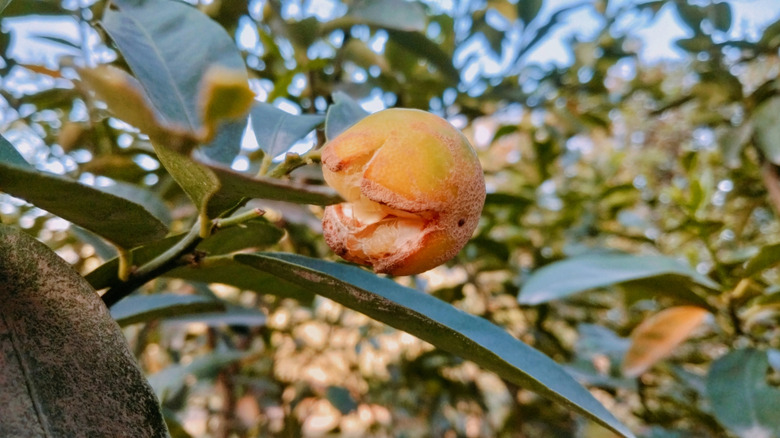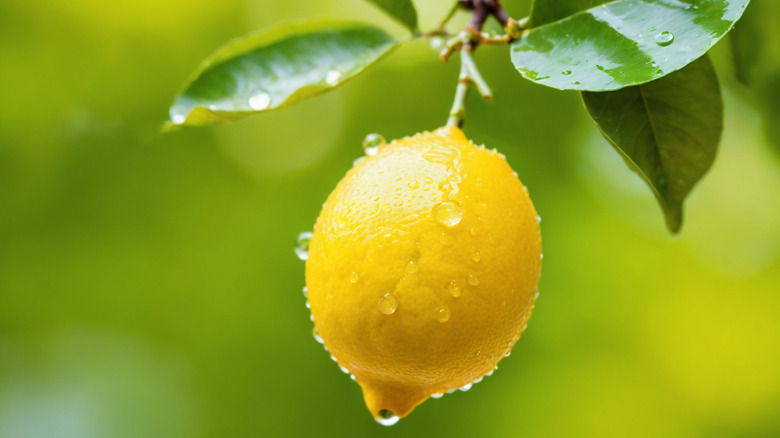Avoid Making These Mistakes With The Lemon Tree In Your Garden
Lemon trees are a great way to add beautiful elements to your landscape — with some varieties even available as indoor plants — while also growing some of your own produce. Unfortunately, there are a variety of problems and mistakes that can derail your citrus journey. These issues can range from trying to grow lemons in regions that are too cold to not providing them with the right lighting conditions or sufficient wind protection. Inadequate fertilizing, a lack of pest and disease prevention, and improper watering can also leave you lemonless.
Lemon trees (Citrus x limon) are likely native to India, but have been grown throughout the Mediterranean and Middle East for thousands of years and are now commonly grown around the world. As the trees rarely grow larger than 20 feet tall, they can be good additions to even relatively small yards, and there are a range of different types of lemon trees available to choose from, depending on your needs and preferences.
Growing lemon trees in cold regions
One of the most basic, but also more damaging, mistakes you can make when growing a lemon tree is not considering its cold tolerance. Most lemon trees are only hardy in zones 9 through 11. Gardeners in colder climates aren't completely out of luck though. One option is to grow Meyer lemons (Citrus x limon 'Meyer'). This distinctive hybrid produces stunning citrus in zones as low as 8b. It also stays on the smaller side, rarely growing past 10 feet tall.
If you live in an area too cold for even Meyer lemons to thrive, you can consider growing your lemons and other citrus fruits in pots. Then you can bring them inside for the winter before returning them to your garden once spring arrives. Just be sure to harden off your trees when changing their location, so that the plants can acclimate to their new environment without too much stress.
The importance of providing lemon trees with sunlight and wind protection
In addition to protecting your lemon tree from cold temperatures, you also need to be careful to protect it from high winds. So be sure to spend some time thinking carefully about the best location before planting a lemon tree in your yard. One of the advantages of growing lemon trees in pots is that you can easily relocate them if you're struggling to find the best location for the plants to thrive.
It's not just protection from wind you need to consider when looking for the best spot for your lemon tree, either. You also need to make sure you provide most lemon trees with full sun. While Meyer lemons are slightly more shade tolerant and can handle part sun if necessary, they still grow best with plenty of sunshine. They also produce more fruit in full sun locations.
Inadequate fertilizing can harm your lemon tree and leave you without fruit
Lemon trees need to be fertilized during their growing season, but it's always a good idea to do a soil test first to find out what nutrients are already in your soil and what needs to be added. When doing your soil test, you should also check the pH of your soil, as lemon trees thrive in acidic and neutral soil. If your soil is too alkaline, lower the pH using amendments to provide a better growing environment for your tree.
Make sure to use balanced or nitrogen heavy fertilizers, ideally those that are designed for citrus trees. Be careful not to over-fertilize your lemon tree though, as this can result in beautiful foliage growth but few flowers and fruits. It's important not to fertilize your tree too late in the growing season either, which can cause it to have a lot of new growth that can be damaged during the winter.
Not staying on top of pests and disease can devastate your lemon trees
Unfortunately, there are a wide variety of diseases and pests that can damage or even kill lemons and other citrus trees. These range from problems like whiteflies, aphids, and mites to citrus-specific problems like the dreaded and deadly citrus greening disease (Huanglongbing) bacterial infection. Providing your tree with wind protection and plenty of sunshine can make it less susceptible to some problems,like the bacteria that causes citrus blast. Trees that are already damaged or stressed can be more easily infected.
Some citrus tree problems are inevitably fatal and the best thing you can do if prevention fails is to remove an infected tree to try to protect any other susceptible plants you may have. However, many other problems can easily be fixed if you catch them early. For example, there are a few options for whitefly control on citrus trees. Beneficial predatory insects like lacewings can be helpful, as can setting sticky traps. If the problem is severe, there are even insecticidal sprays that you can turn to. Just make sure to follow all instructions carefully.
Improper watering can destroy lemon trees
Lemons need to be watered regularly, and it's important not to let their soil dry out completely. However, they can also be harmed by overly waterlogged soil, so it's important to find the right balance. A good rule of thumb is to water the tree when the soil about 2 inches underground is dry. You should also keep in mind that the water requirements for lemon trees vary by season, and they require far less water in winter months. Additionally, mature trees generally need to be watered less often than young ones.
It's not just about how often you water your lemon trees, it's also important to consider your watering technique. Try to avoid overhead watering your lemon tree as much as possible, as spraying the leaves and blossoms while watering can actually make the tree more vulnerable to disease. It's similarly important to avoid getting the tree's trunk too wet during watering, as this can also increase the risk of diseases and fungal infections.
